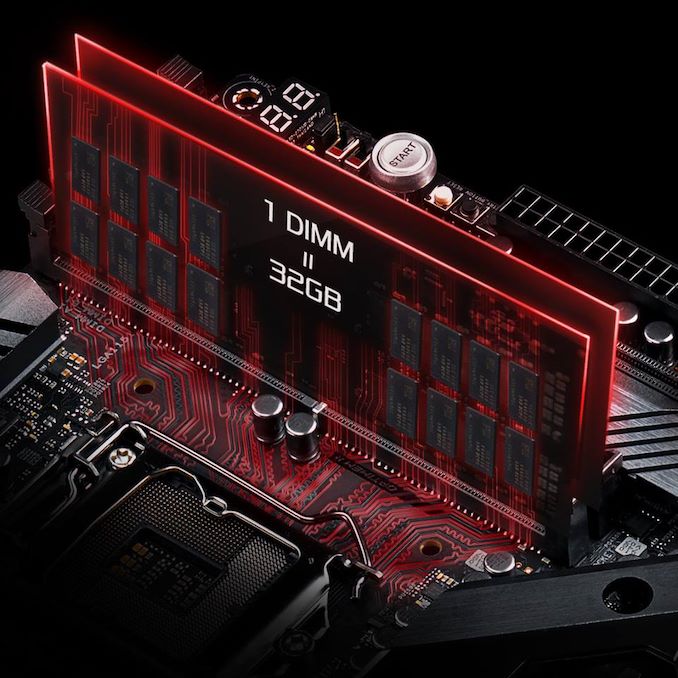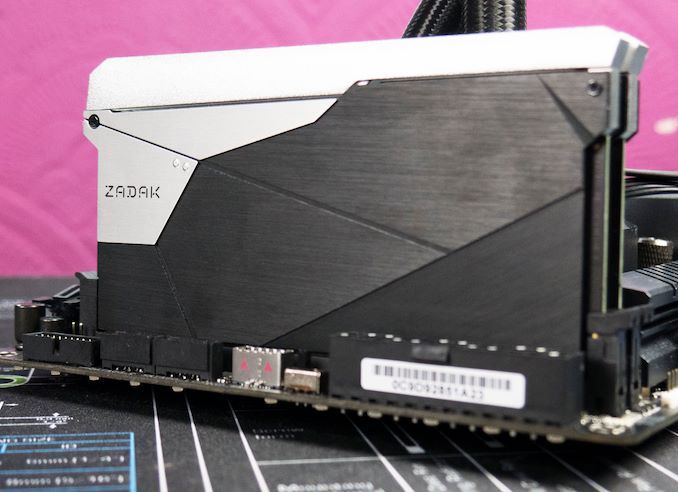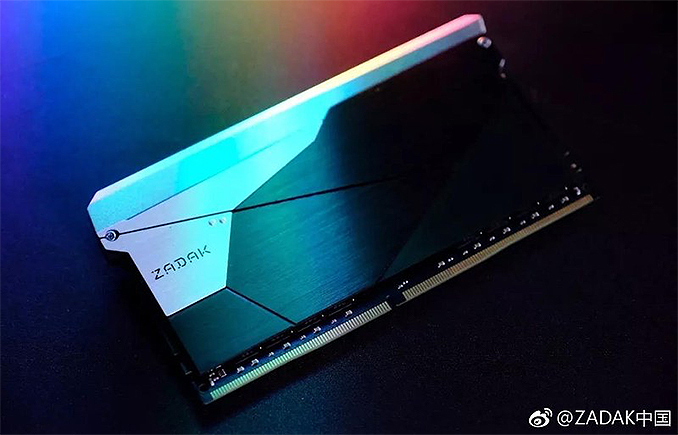Double Height DDR4: 32GB Modules from G.Skill and ZADAK Reviewed
by Ian Cutress & Gavin Bonshor on January 23, 2019 9:00 AM ESTZADAK Shield RGB DC DDR4-3200 Overview
We first learned about the new ZADAK 32 GB modules back in September. Since then, ZADAK has announced a total of five different 2x32GB Shield RGB DC kits in four different clock speeds, from DDR4-2666 through to DDR4-3600. There are two kits available at DDR4-3200 with different latencies; at CL14-14-14-34 and with slightly looser secondary and tertiary timings of CL14-16-16-36. All of these kits are compatible with three specific ASUS ROG Z390 models: the STRIX Z390-I Gaming, MAXIMUS XI APEX and MAXIMUS XI Gene.
For this review, we received a kit of the DDR4-3200 CL14-16-16-36. This dual channel 64 GB (2x32 GB) kit has an operating voltage of 1.35 V and features Samsung B-Die ICs. By contrast to ZADAKs other kits on the market, this is quadruple the capacity of its 8 GB UDIMMS.

ZADAK Shield RGB DC Memory in an ASUS Z390 Motherboard
While we know the ZADAK Shield RGB DC memory has a total of 32 memory ICs on its PCB (16 on each side), and it uses a similar pin-out implementation to G.Skill, leading to the specialization that they only work on select ASUS motherboards that have been validated. Unfortunately the ZADAK headspreader is firmly bonded to the chips, meaning removing the headspreader has a chance that it could remove a chip; we were unable to secure any images from ZADAK for underneath the heatspreaders, so at this point we are assuming that they work similarly to the G.Skill modules with double EPROMs onboard and act as two DIMMs on one PCB.
Analyzing at the mechanical design of the ZADAK Shield RGB DC DDR4-3200 memory, they are 73 mm in height which isn't much taller than ZADAKs own 8 GB Shield RGB memory which have a height of 60 mm. This means the heatsinks extend quite a bit further than the PCB with the majority of the height coming as a result of the integrated RGB LED lightbar. The heatsinks feature a three-tone design with black, grey and silver aluminium heat spreaders. The effect is not as pronounced as the G.Skill RGB light bar.
The RGB LEDs built-into the top of the heat spreader is addressable and can be customized with ASUS AURA software.
ZADAK in itself is an arm of Apacer Technology who formed back in 1997 as a DRAM supplier. ZADAK formed in 2015, and would prefer to be identified as a separate entity from Apacer, similar to how HyperX is to Kingston, or Crucial is to Micron.
Using the Taiphoon Burner DRAM software, we can see the JEDEC DIMM Label is listed as 16 GB of 2Rx8. This means the sensor is showing that each module is organised by the firmware into two lots of 16 GB and not one of 32 GB. The latency timings of the XMP 2.0 profile are 14-16-16-36.
ZADAK has better market variation with a total of five different kits.
The baseline model is a DDR4-2666 kit which is the cheapest of the five models at $799 and has timings of 16-16-16-36. This is relatively slow in terms of latency timings for a kit of this speed overall, but so far its the only DC kit from any vendor to operate at just 1.2 V on its XMP 2.0 profile.
Stepping up to the next mark is a DDR4-3000 kit with slightly slower timings of 16-16-18-38 for $899 and operates at 1.35 V. There are two DDR4-3200 kits available with both kits having the tightest timings, and a final DDR4-3600 kit. This DDR4-36000 kit has an MSRP of $1299 USD which is $500 premium over the DDR4-2666 base model which is a considerable chunk of budget for a desktop platform.
| ZADAK Shield RGB DC Kits for ASUS Z390 Platform | |||||||
| Speed | CL Timing | Voltage | Kit Config. |
PN | MSRP (USD) |
||
| DDR4-2666 | CL16 16-16-36 | 1.20 V | 2×32 GB | - | $799 | ||
| DDR4-3000 | CL16 16-18-38 | 1.35 V | - | $899 | |||
| DDR4-3200 | CL14 14-14-34 | - | $1199 | ||||
| CL14 16-16-36 | ZD4-SHC3200C14-32GCS | $999 | |||||
| DDR4-3600 | CL16 18-18-38 | - | $1299 | ||||
The DDR4-3200 kit which we received for testing has slightly looser timings of CL14 16-16-36 and has a price of $999.
The current availability in retail channels of the ZADAK Shield RGB DC 2x32 GB kits is limited to Japan, China and Australia. ZADAK has stated that its DC kits will be available in Vietnam and Thailand during January, while the kits are planned for launch in the US and EU during Q1 2019.















50 Comments
View All Comments
Alim345 - Wednesday, January 23, 2019 - link
It’s not clear whether it is possible to use four sticks. Probably it is not since those sticks replicate what should happen in motherboard.Targon - Thursday, January 24, 2019 - link
Much of that would be a function of the chipset/BIOS and the memory controller which is on the CPU these days. These double height modules can't directly talk to the memory controller as if they are two modules, because the memory slots themselves and how they talk to the chipset/memory controller/CPU are not different.That is why I wanted to see at least an attempt to get these to work with a socket AM4 system and see how they show up. Going from 1T or 2T to 2T or 4T for the memory is probably the issue, and if the chipset would even allow it. Asking Asus if they have plans to allow DDR4 to run with a 4T command rate on more boards would be worth the call.
nevcairiel - Wednesday, January 23, 2019 - link
Since one of those DIMMs basically acts like two DIMMs, you probably cannot use two of them on the same channel, since that would require supporting 4 DIMMs on the same channel.Targon - Thursday, January 24, 2019 - link
I don't think it works that way. Yes, internally each one is working as if it was two, but how the module talks to the BIOS/chipset/processor is the big question. Does the BIOS need to support a 4T command rate on the memory for these to work, and if so, that explains why support is limited.Bp_968 - Thursday, January 24, 2019 - link
He explained in the article that the way memory channels are handled that the traces are daisy chained or combined. These dimms act as 2 dimms slapped onto one card and won't work stacked 2 too a channel (because then you'd have 4 dimms on a channel).Above and beyond that you also have the fact that now 32GB modules exist which render these far less useful. There are very very few scenarios where you'd want 128GB of ram and not want it to be ECC RAM. Any sort of server and many workstation tasks I'd much prefer to use ECC ram instead.
yuhong - Wednesday, January 23, 2019 - link
Even Intel don't usually update ARK or the datasheet.alpha754293 - Wednesday, January 23, 2019 - link
Maybe I'm missinng something here - but I don't understand why people just don't get 32 GB DDR4-2666 ECC Registered DIMMS like this one (https://www.newegg.com/Product/Product.aspx?Item=N... and be done with it?It's going to run about the same price and they can just overclock it.
Wixman666 - Wednesday, January 23, 2019 - link
Because most boards don't run ECC memory. These are a niche product to get 64GB on boards that only have 2 slots. Lots of memory doesn't overclock well. You're making assumptions with your statement that are completely off base.CheapSushi - Thursday, January 24, 2019 - link
Does that mean ECC RAM will NOT WORK AT ALL or just the ECC portion, soft error correcting, won't work but it'll show up like regular RAM?alpha754293 - Thursday, January 24, 2019 - link
I've used ECC memory on consumer grade boards. All that happens is that the ECC part of the ECC, Registered RAM gets disabled and the rest of the DIMM module functions like a UDIMM instead of a RDIMM."You're making assumptions with your statement that are completely off base."
Yes! Which is why I literally said: "Maybe I'm missinng something here - but I don't understand why people just don't get 32 GB DDR4-2666 ECC Registered DIMMS like this one (https://www.newegg.com/Product/Product.aspx?Item=N... and be done with it?"
Lots of memory don't overclock well is just a broad and generic statement that can also be applied to these modules as well.
The fact of the matter is that DDR4-3000 and DDR4-3200 modules ARE overclocked by default anyways because those speeds aren't part of the JEDEC JESD79-4 spec (p.163).
Here is a 32 GB module from Micron Technology, DDR4-3200, ECC Registered: https://www.ebay.com/itm/Micron-MTA36ASF4G72PZ-3G2...
The point being that a) they exist already and b) you should be able to disable the ECC, registered capabilities of these DIMMs. (I've never had a consumer grade board that didn't know how to ignore the ECC registered capabilities of RDIMMs.)
In other words, you can already do this with existing modules that you can buy, at those speeds, "second" hand (which tells you a little bit about the maturity of the tech).